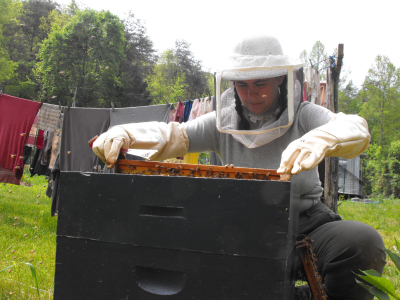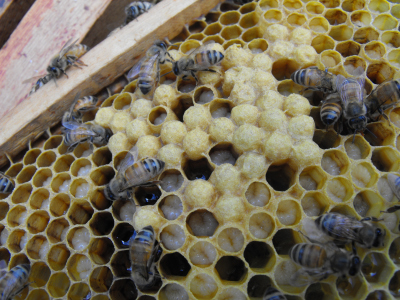
Queen excluder and drone debate
 When
we started our hives last year, we had to take a stand in the great
excluder debate. A queen excluder is basically a screen that you
place between the brood box and the honey supers to ensure that the
queen stays down where you want her and doesn't head up to lay eggs in
the honey frames. Some folks swear by excluders, but other people
point out that excluders make your hive more likely to swarm since your
brood box can get congested in the spring. We opted to join the
anti-excluder camp primarily because I knee-jerk in favor of anything
that sounds more natural, and because I am too cheap to buy equipment
we don't really need.
When
we started our hives last year, we had to take a stand in the great
excluder debate. A queen excluder is basically a screen that you
place between the brood box and the honey supers to ensure that the
queen stays down where you want her and doesn't head up to lay eggs in
the honey frames. Some folks swear by excluders, but other people
point out that excluders make your hive more likely to swarm since your
brood box can get congested in the spring. We opted to join the
anti-excluder camp primarily because I knee-jerk in favor of anything
that sounds more natural, and because I am too cheap to buy equipment
we don't really need.
Last year, our lack of
an excluder caused absolutely no problems. Our bees were working
hard to build up their hive, and the queen had no time or inclination
to lay eggs in the honey supers. This year, though, I noticed
that two of our hives have a bit of drone brood at the bottom of the
lowest honey super. Which brings us to beekeeper debate number
two: are drones a drain on the hive or an asset?
I won't go into bee
biology too far, but you need to understand that there are three kinds
of bees in a honeybee hive. There's the queen --- one per hive,
who lays all of the eggs and does nothing else. There are the
workers --- many, many per hive, who do all of the work from foraging
for pollen and nectar to cleaning the hive and raising the babies
(brood.) Then there are the drones --- the only males in the
hive, whose sole purpose is to head out every day in search of a
mate. Since the queen only has to copulate once in her life, you
can see that keeping a bunch of drones on tap is wasteful --- they eat
like crazy and don't pull their weight. As a result, many
beekeepers try to keep drone production to a minimum.
 Drone
management comes down to managing the cell size in the brood box since
the queen decides whether to lay eggs that will become workers or
drones based on the size of the cell. Big cells are for drones;
small cells are for workers. When drones reach their pupal stage,
they're too big to fit into even their extra large cells, so workers
build a little domed cap to seal the drone pupa in rather than the flat
caps they build over worker brood. As a result, it's pretty easy
for us to take a look at capped brood and know at a glance how much of
it will turn into workers and how much into drones --- the photo here
shows the domed caps of drone brood (along with some drone larvae too
young to be capped.) Beekeepers who want to limit drone
production will cut out drone-sized comb and replace it with
worker-sized comb so that the queen will lay the latter rather than the
former.
Drone
management comes down to managing the cell size in the brood box since
the queen decides whether to lay eggs that will become workers or
drones based on the size of the cell. Big cells are for drones;
small cells are for workers. When drones reach their pupal stage,
they're too big to fit into even their extra large cells, so workers
build a little domed cap to seal the drone pupa in rather than the flat
caps they build over worker brood. As a result, it's pretty easy
for us to take a look at capped brood and know at a glance how much of
it will turn into workers and how much into drones --- the photo here
shows the domed caps of drone brood (along with some drone larvae too
young to be capped.) Beekeepers who want to limit drone
production will cut out drone-sized comb and replace it with
worker-sized comb so that the queen will lay the latter rather than the
former.
Now we come back to the
queen excluder. Without the excluder, when the brood box starts
filling up but the queen still feels like laying eggs, she'll move up
into the first honey super to lay. The problem is that honey
cells are large, so the queen lays all drones up there --- a drain on
the hive. On the other hand, a
fascinating article by Walt Wright makes the point that natural
hives keep 20% of their brood area in drones and that the hive will
build all kinds of jurry-rigged drone cells if we prevent them from
laying that 20%. He concludes that it's better to go ahead and
let the hive produce drones rather than running the risk of lowering
honey production with a queen excluder.
I'm still in the
learning stages of bee management, so I'm taking a bit of a wait and
see approach. If there's a lot more drone brood at our next hive
check, I'll probably put a super of foundationless frames beneath the brood box,
letting the hive build more worker cells for the queen to lay in.
That way, the queen will get to keep expanding the worker population,
which will mean more nectar brought in from the field and more honey
for the winter. On the other hand, if there's still just a bit of
drone brood at the bottom of the first honey super, I'll figure the
hive deserves their boy toys and leave it alone.
| This post is part of our Farm Experiments lunchtime series.
Read all of the entries: |
Want more in-depth information? Browse through our books.
Or explore more posts by date or by subject.
About us: Anna Hess and Mark Hamilton spent over a decade living self-sufficiently in the mountains of Virginia before moving north to start over from scratch in the foothills of Ohio. They've experimented with permaculture, no-till gardening, trailersteading, home-based microbusinesses and much more, writing about their adventures in both blogs and books.
Want to be notified when new comments are posted on this page? Click on the RSS button after you add a comment to subscribe to the comment feed, or simply check the box beside "email replies to me" while writing your comment.

Anna one option would be to include one shallow frame amongst your regular sized brood frames. The bees will always fill the sort of space which that leaves beneath it, and will preferentially build themselve a comb of drone brood if that is what they sense they need. It will then be quite obvious to you where the drone brood is, and very easy to cull it if you want to. I think that will work better than frames without foundation, where the combs may not be built so neatly and you could end up getting very messy with brace comb being built joining the frames together. A single shallow frame amongst the deeper brood frames is likely to be all they need.
In the UK we do that as part of varroa mite control: varroa mites prefer drone brood, so culling it gets rid of a good number of mites. Personally I'd leave the drones to develop if it wasn't for the varroa problem. The reason nature produces more drones than queens needing to be mated is that it improves the chances of mating even in adverse circumstances. There is only a brief window of opportunity for mating and if the queen misses that due to bad weather the colony is doomed. It's not only your own queen to consider - with the problems with bees we need to ensure as many queens as possible get safely mated in every neighbourhood.
I do enjoy your site. Found it form kyhomesteadblogspot, via countrysidemag. Have just got first chickens this week. Judith
Good reminder about culling drone brood to deal with varroa mites! So far, we haven't had to do that --- we have a screened bottom board, and when I checked on mite levels last fall and winter, they were within manageable range. I should probably check again, though!
We've actually had really good luck with foundationless frames. (It's not quite as simple as not using foundation --- I do provide the bees a little strip to get them building in the right direction.) They built nearly everything straight and included spaces for drones amid the worker brood. I think that I'm running into is that one deep isn't enough space for all the brood they want to raise! I've been reading lately that if you give them more space for brood, they'll fill it up and will have masses of workers, which means more honey. I'm in favor of more honey.
Very interesting! Glad to see you're doing pretty well in your second year. We're hoping to get started this year, yet, if we can find someone to sell us some bees! Our hives are on the way, at any rate.
I've been reading everything I can. We're trying our hand at the top bar hives, though. I can't find too much on management specifically for them, though.